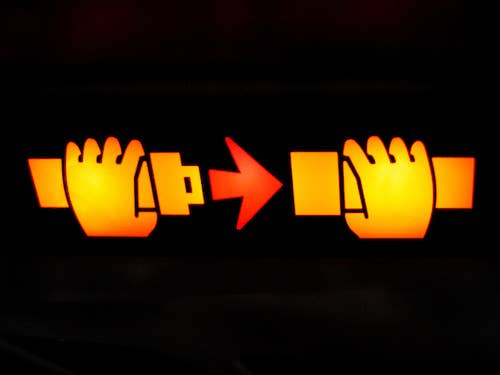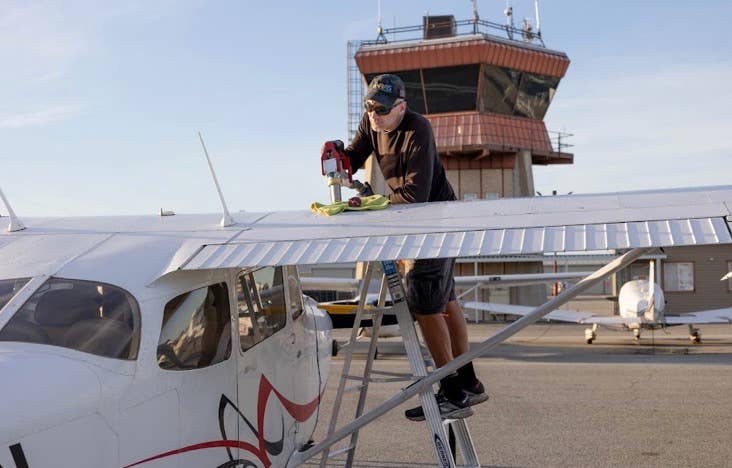
"From ghoulies and ghosties and long-leggedy beasties and things that go bump in the flight, Good Lord deliver us." With apologies to Robert Burns.
Surf's Up! My flying partner last week was Jim, a longtime pilot, friend and Piper Aztec owner. He was giggling because we hit a bit of turbulence that was harsh enough to make me almost jam a plastic fork in my head as I tried to fly the plane and eat my chicken salad simultaneously.
"It is getting a little gnarly up here today," Jim said as he reached down and tightened his lap belt. "You seem to be handling it OK for an old guy."
The Aztec, an aircraft I flew way back during my brown hair days, was riding the rough air like a cork on an ocean of angry red wine. I had flown Aztecs through way worse air than this, although my absolute worst ride in a light twin was when I was flying a Baron late at night and accidentally fell into the clutches of a thunderstorm.
In that episode, my legs flew up and smashed against the bottom of the instrument panel. I still have a little scar on the top of each knee.
My other "war with the wind" wounds are little unseeable scars on the top of my head. They are covered, for now, by my thinning hair. I got two little puncture boo-boos when flying copilot on the 727. We hit some severe turbulence, and I flew up and smashed my noggin against the engine anti-ice switches on the overhead.
Jim was doing OK with the bumps this morning. His last job was flying MD-11s for a package hauler. He had flown all over the world and had seen his share of bouncy aviating. He was drinking a half-full cup of coffee without a sippy-cup lid and keeping it all in the Styrofoam container, deftly letting his drinking hand rise and fall with the bumps.
This coffee technique is a sign that you are dealing with a pro. I, too, can manage a full cup of alert juice. Doing it successfully in an airplane is easy. Try doing it at 3 a.m. during the van ride from Manhattan to Newark. The potholes you run into on your average New York layover van trip are far more violent than most turbulence you'll encounter in the air.
I made it a point to finish my chicken salad even though the air had gotten rougher, and I almost jammed some of it up my nose. It was getting bumpy enough to try to mitigate it through a crafty search for smooth air. I had Jim ask for a lower altitude.
In the airline world, we try to get to a calm ride by changing altitude or our course. The altitude switch is the easiest because it is hard to fly laterally out of a patch of rough stuff that can extend in a blob for hundreds of miles.
When flying jets, changing your altitude based on ride reports from other aircraft is a tried-and-true method. Even if it doesn't work, you feel at least like you are doing something. I would usually make a PA (public announcement) to the passengers, saying: "Sorry for the bumpy air, folks. Other aircraft in the area have reported that the bumps are a little less at the lower altitudes, so we will descend to 31,000 feet and see if we can't give you a better ride. For now, please stay seated with your seat belts on. I have asked our flight attendants to be seated for their safety."
Notice that I did not use the words "turbulence," "extreme" or any other dire-sounding terms. They could be awash in dropped oxygen masks and fallen ceiling panels back there, and the most any good captain should say is "really rough air" or "it is getting choppy." No need to set off a panic about something they cannot change.
The most important thing is to give the flight attendants enough time to secure the meal and beverage carts before it gets bad. An airborne cart is a lethal weapon. This is a tough call to make because you really can't tell what the ride is going to be like, and in light chop, the carts give the flight attendants something to hold on to, and having the carts out in the aisle has the added advantage of keeping the passengers in their seats.
In the general aviation world I live in now, altitude changes in a non-turbocharged air breather like the Aztec are somewhat futile. It will climb slowly, and you have a small selection of altitudes available to try. If you are bouncing through a cloud layer and know it is clear of clouds up a little higher, go for it. The 2000-foot lower altitude Jim got me was not doing much for us.
Unexpected clear air turbulence seems to be more prevalent in today's skies. Nothing gets the public's attention faster than someone getting seriously injured or dying during a turbulence encounter.
Some blame global warming, and they may be right. I don't know. I do know that these sorts of accidents happen every year, usually during the cross-over time between winter and spring, and the injuries usually happen to people not wearing their seat belts or, unfortunately, to cabin crew trying to do their jobs.
International flight crews usually leave the seat belt sign on almost the entire flight, especially at night. This is for two reasons. First, because of the long length of the flight it is always terribly bumpy at some point. Second, we left it on so we would not have to bother the passengers with repeated PA announcements about having the silly light on when most of them were trying to sleep.
There is background communication between the flight attendants and the flight crew. Sometimes, the flight attendants asked us to turn the sign on because it was getting bumpy, but more often, they asked us to turn it on because there were way too many passengers up on their feet, clogging the galley and the aisles during meal service.
I always had a policy of telling my flight attendants that I would always turn the seat belt sign on if they asked and that they should sit down and strap in any time they liked and then tell me. They were always the final authority on how rough it was in the back.
My luck held out, and during my subsonic people-moving career, I never sent a flight attendant or a passenger to the hospital.
Now that I am back to flying the general aviation aircraft of my youth, I usually handle turbulence by postponing my flight. I do not need to prove myself or push weather.
Professional pilots often do not have the option of waiting for a better day to go flying. Still, they do have the advantages of having heavy, high-performance aircraft, professional crew members and the vast resources of their airline's dispatch office.
Our ride in Jim's Aztec was getting a little quieter. I heard some snoring and noticed he had zoned out and was "watching for satellites." I gave the column a short, sharp bump, waking Jim up with a start.
"Bumpy air again?" he asked.
"You know what I always say about a lousy ride, don't you?" I asked. "It is going to get better, worse, or stay about the same."






